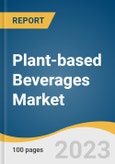The global plant-based beverages market size is expected to reach USD 71.83 billion by 2030, registering a CAGR of 13.1% from 2023 to 2030. There is significant scope for the growth of the global industry as the concept of veganism is gaining prominence in developed countries, such as the U.K., U.S., Australia, New Zealand, Germany, Italy, France, and Canada. In addition, various Middle Eastern countries such as Israel and Saudi Arabia have been witnessing a growth in the vegan population, which offers several growth opportunities for plant-based beverage manufacturers. Major players as well as new entrants in the industry are adopting various market strategies, primarily new product launches, and strengthening their distribution channel to gain maximum customer penetration across the globe.
For instance, in April 2021, Nestlé announced the launch of a plant-based, ready-to-drink (RTD) version of its Milo cocoa beverage in Asia, along with two plant-based coffee RTDs. The new plant-based version of Milo will replace the dairy milk with almond and soy and the other two core ingredients-malt and cocoa-remain the same. The demand for organically processed beverages is significant in the European and North American regions. The rising demand has compelled beverage companies to reformulate products to meet organic standards over the years. Increasing government support for organic agriculture and the rising popularity of organic food & beverages among consumers have driven the demand for organically processed plant-based beverages.
Coconut-based beverages are anticipated to register the fastest CAGR during the forecast period. New product launches in this segment are likely to be among the key drivers supporting the market growth. For instance, in April 2020, Harmless Harvest added three new flavored coconut water drinks to their classic organic coconut water line. The flavored plant-based beverages segment is expected to register a significant CAGR over the forecast period. Consumers are willing to experiment with flavors, such as mango, pulp, and cocoa. Therefore, new flavor launches in the existing product portfolio along with partnerships, collaborations, and marketing campaigns are some of the strategies that brands and companies opt for to gain a competitive edge in the industry.
This product will be delivered within 1-3 business days.
For instance, in April 2021, Nestlé announced the launch of a plant-based, ready-to-drink (RTD) version of its Milo cocoa beverage in Asia, along with two plant-based coffee RTDs. The new plant-based version of Milo will replace the dairy milk with almond and soy and the other two core ingredients-malt and cocoa-remain the same. The demand for organically processed beverages is significant in the European and North American regions. The rising demand has compelled beverage companies to reformulate products to meet organic standards over the years. Increasing government support for organic agriculture and the rising popularity of organic food & beverages among consumers have driven the demand for organically processed plant-based beverages.
Coconut-based beverages are anticipated to register the fastest CAGR during the forecast period. New product launches in this segment are likely to be among the key drivers supporting the market growth. For instance, in April 2020, Harmless Harvest added three new flavored coconut water drinks to their classic organic coconut water line. The flavored plant-based beverages segment is expected to register a significant CAGR over the forecast period. Consumers are willing to experiment with flavors, such as mango, pulp, and cocoa. Therefore, new flavor launches in the existing product portfolio along with partnerships, collaborations, and marketing campaigns are some of the strategies that brands and companies opt for to gain a competitive edge in the industry.
Plant-based Beverages Market Report Highlights
- The Asia Pacific was the largest region in 2022 owing to the increasing vegan/vegetarian population in countries including China, India, and Australia
- The flavored plant-based beverages segment is anticipated to register a considerable CAGR from 2023 to 2030
- New product launches in this segment by various brands are the key factor propelling the segment growth
- The coconut-based beverages segment is anticipated to register the fastest growth rate during the forecast period
- Key players in the industry are launching coconut-based beverages with added flavors to gain maximum share
This product will be delivered within 1-3 business days.
Table of Contents
Chapter 1. Methodology and Scope
Chapter 2. Executive Summary
Chapter 3. Plant-based Beverages Market Variables, Trends & Scope
Chapter 4. Consumer Behavior Analysis
Chapter 5. Plant-based Beverages Market: Type Estimates & Trend Analysis
Chapter 6. Plant-based Beverages Market: Product Estimates & Trend Analysis
Chapter 7. Plant-based Beverages Market: Regional Estimates & Trend Analysis
Chapter 8. Competitive Analysis
List of Tables
List of Figures
Companies Mentioned
- Danone S.A.
- Pacific Foods of Oregon, LLC
- Blue Diamond Growers, Inc.
- SunOpta
- The Hain Celestial Group, Inc.
- Noumi Ltd.
- Califia Farms, LLC
- Harmless Harvest
- Koia
- Vitasoy International Holdings Ltd.
Methodology

LOADING...
Table Information
| Report Attribute | Details |
|---|---|
| No. of Pages | 100 |
| Published | July 2023 |
| Forecast Period | 2022 - 2030 |
| Estimated Market Value ( USD | $ 26.8 billion |
| Forecasted Market Value ( USD | $ 71.83 billion |
| Compound Annual Growth Rate | 13.1% |
| Regions Covered | Global |
| No. of Companies Mentioned | 10 |









